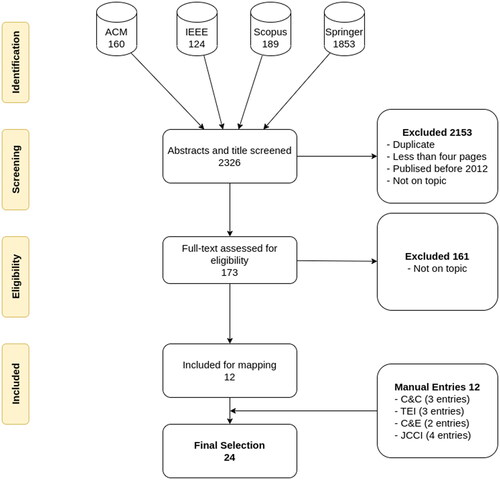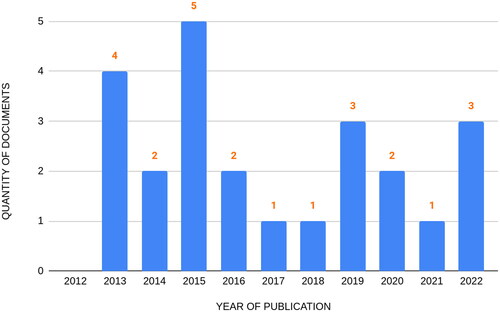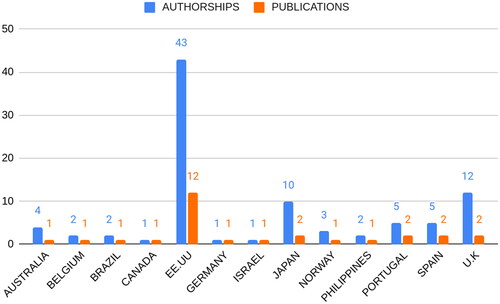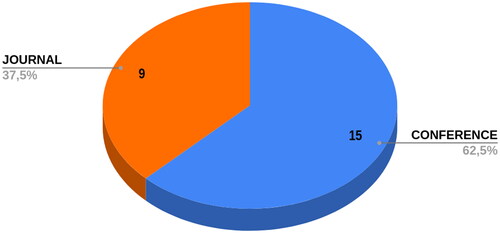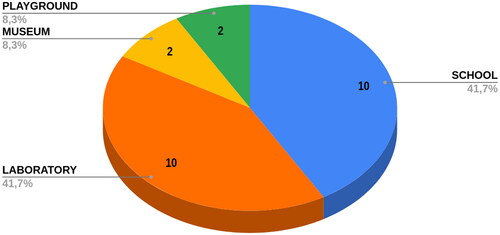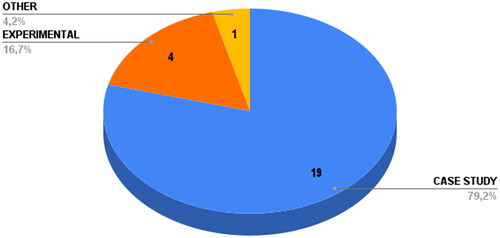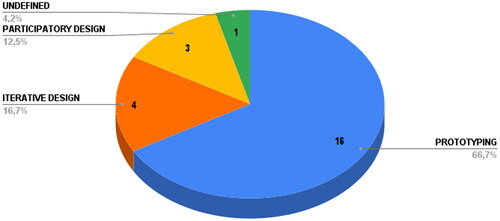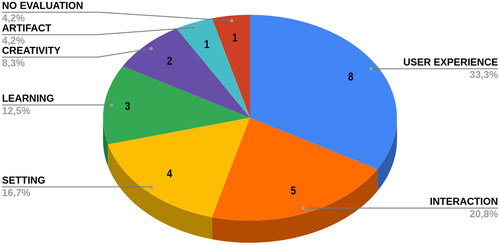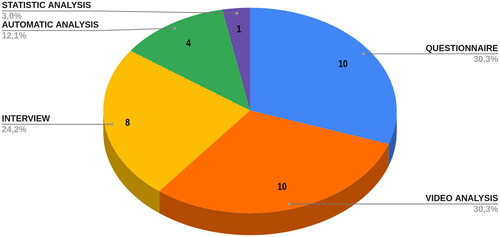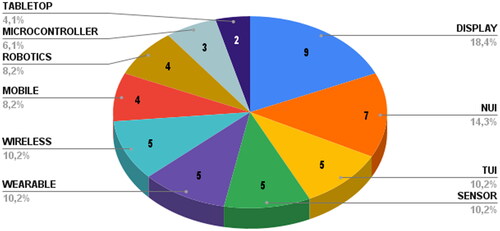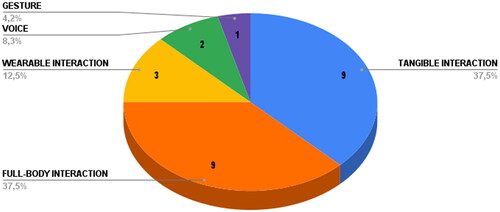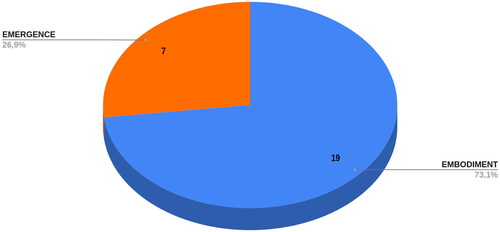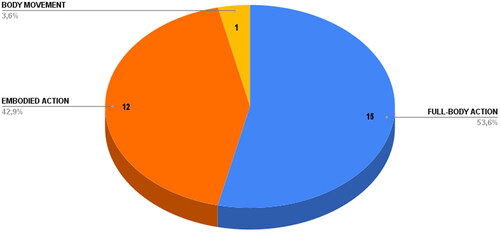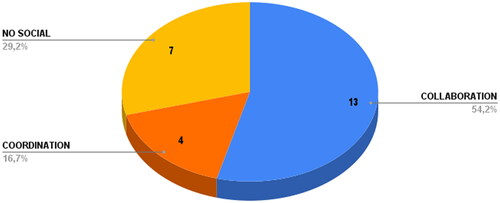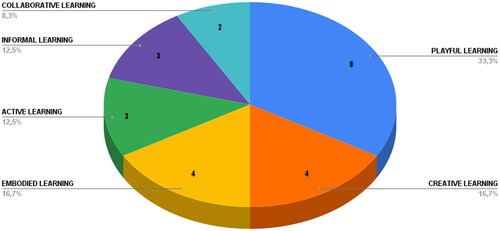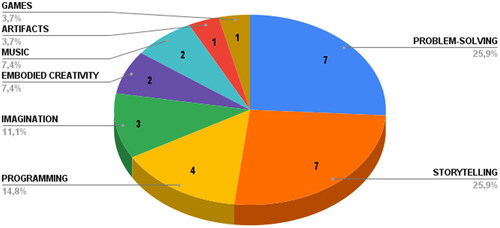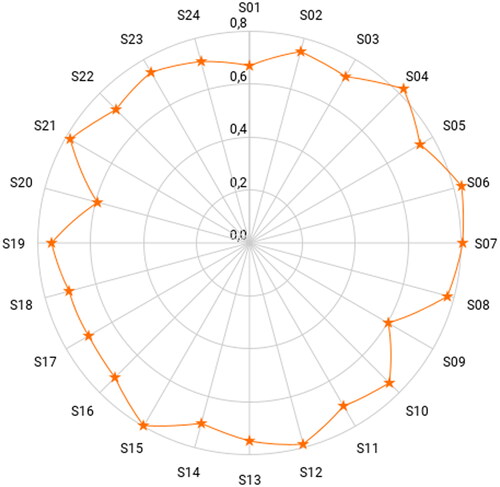 ?Mathematical formulae have been encoded as MathML and are displayed in this HTML version using MathJax in order to improve their display. Uncheck the box to turn MathJax off. This feature requires Javascript. Click on a formula to zoom.
?Mathematical formulae have been encoded as MathML and are displayed in this HTML version using MathJax in order to improve their display. Uncheck the box to turn MathJax off. This feature requires Javascript. Click on a formula to zoom.Abstract
Creative learning can be understood as a process of personal transformation driven by the acquisition of new knowledge and skills through active participation in projects that are meaningful to the individuals. This process enables them to develop the capacity for innovation in different contexts. Contemporary technologies that allow more physical and immersive modes of interaction brought the concept of enactive systems, technological environments where there is a form of dynamic body-technology coupling. In this work, we present results from a systematic literature review of studies that supported creative learning using interactive environments with enactive characteristics, in educational contexts. The systematic review was conducted based on works published during the period of 2012–2022. The methodology details the research questions, selection criteria, search string, data collection and the quality and relevance of the selected documents. Results showed that environments of the selected studies present mainly the embodiment and emergence characteristics as part of their interaction. These environments promoted user initiatives, enabled users to think creatively and encouraged communication and collaboration. Results also point out other aspects of enactive approaches to cognition such as autonomy, sense-making, and intersubjectivity.
1. Introduction
The enactive approach to cognition was initially conceived as an embodied and phenomenologically informed alternative to mainstream cognitive science (Varela et al., Citation2017). Enactivist approaches to cognition suggest that cognitive processes are not just in the head, but involve bodily and environmental factors. In this sense, an enactive approach considers sensory “input” and motor “output” as two facets of the same process of generating meaning. There are five highly intertwined ideas that make the notion of enaction: autonomy, sense making, emergence, embodiment, and experience (Di Paolo et al., Citation2010; Thompson, Citation2010; Varela et al., Citation2017). These ideas partially imply each other. The term embodiment is related to the idea that cognition evolved from action, and because of this, perception and action are not separate systems, but are inextricably linked to each other and to cognition. An enactive approach to interaction design demands a radical thinking of design, a design for experience, where human–computer interfaces (HCIs) become “transparent” tools that empower users to explore the world in new and intuitive ways (Pacheco & Souza-Concilio, Citation2013).
In people’s daily lives and education, digital technologies influence their cognitive development, including their creativity. The research of Xiong et al. (Citation2022) has demonstrated a positive correlation between the use of technological devices for creative activities, and the enhancement of children’s cognitive abilities, particularly in the area of creative thinking. However, traditional tools may not be enough to successfully foster creative behavior, imagination, and playfulness that technology has the power to cultivate (Sullivan & Bers, Citation2018). The rise of gesture-controlled interfaces is transforming learning (Scheiter et al., Citation2020), leading to a rapid expansion of interactive and engaging learning experience. For Scheiter et al. (Citation2020, p. 2), “the interest in embodied learning is increasing as research has found that the enacting of knowledge and concepts through bodily activity can support learning”. In addition, the empirical study of Bitu et al. (Citation2022) contributes to a better understanding of the process of creativity, revealing that creativity is linked to sensorimotor components. The authors argue that sensory afferences are essential for the process of creative thinking. In this context, we argue that enactive approaches to cognition (Stewart et al., Citation2010; Thompson, Citation2010; Varela et al., Citation2017) may provide new perspectives to consider the design of interactive environments that promote creative learning through more embodied interaction with technology.
Creative learning has been associated with learning by doing something engaging and meaningful to the learner (Papert, Citation1986, p. 1), who developed constructionism, stated that “learning is particularly effective when it is embedded in an activity the learner experiences as constructing a meaningful product (for example, a work of art, a functioning machine, a research report, or a computer program)”. Research on creativity has long asserted that creativity and learning are tightly coupled phenomena (Sawyer, Citation2011). Creative learning is a form of creative expression, which focuses on going beyond reproductive and reinforcement learning and includes the key creative characteristics (Beghetto, Citation2021; Rothenberg, Citation2014; Sawyer, Citation2011) of being both combinatorial (combining existing knowledge with new learning) and emergent (contributing to new and sometimes surprising ideas, insights, perspectives, and understandings to oneself and to others). Creative learning is active learning that involves experimentation, innovation, and invention. It recognizes that people learn in different ways, that they learn better when there is relevance, and that learning can be collaborative and social.
Creative learning, in the context of formal education, allows students to create and develop their projects, working creatively and engagingly with the content of the classes. Creative learning involves a “combination of intra-psychological (individual) and inter-psychological (social) processes that result in new and personally meaningful understandings for oneself and others” (Beghetto, Citation2016, p. 9). The work of Resnick (Citation2006) on creative learning disseminates the principle of learning for life through projects and experiences that allow students to explore and put aside static activities. It is widely accepted that students need to experience creative learning opportunities. However, one of the most important challenges for creative experience is “to establish an environment that promotes the children’s interests” (Aljughaiman & Mowrer-Reynolds, Citation2005, p. 17). Ali et al. (Citation2021) formulated guidelines to design environments that foster creative experiences for children, highlighting that engaging in playful interactions fosters an environment conducive to creative thought, open-endedness activities encourage to explore different possibilities, and collaboration stands as one of the most significant external influences on creative thought processes.
Seen by many authors as exclusively a mental process, creativity is also acknowledged as a cultural and social phenomenon, as argued by Csikszentmihalyi (Citation1998, p. 316): “(…) creativity presupposes a community of people who share ways of thinking and acting, who learn from each other and imitate each others actions”. Still this fact brings new questions to light, some relevant for understanding creative learning environments, such as the role of peers, and the influence of the body in creative action in the environment, to name a few. In this article, we aim to provide a comprehensive panorama of how interactive environments with enactive characteristics address creativity in educational contexts of interaction. Specifically, we aim at examining how learning environments are used, with a special focus on the role of bodily engagement and interaction in the meaning-making process, and how this contributes to creative construction.
Our work is motivated by the fact that fostering creativity is considered essential for the development of crucial skills in our technologically evolving world. This review included key research questions (RQs) about the type of technology used, proposed educational activities, and relation between enactive interaction and creative learning. We analyzed publications from 2012 to 2022 to provide a synthesis from the literature that helps understand how an enactive approach to the interaction design would support creative learning in an educational context. Overall, the contributions of our work are: (i) selected studies that have interactive environments with enactive characteristics that support creative learning in educational contexts, (ii) an analysis of the activities proposed to promote the development of creativity, and (iii) analysis of the relation between enactive interaction and creative learning.
For this purpose, we conducted a systematic literature review (SLR) in four academic bases in the field of Computer Science. This SLR has selected 24 documents addressing interactive environments with enactive characteristics in educational contexts to support creative learning. This article is organized as follows: In Section 2, we describe the background for the SLR conducted. In Section 3, we present the material and methods for this SLR. In Section 4, we present the results, and relevant data extracted from the selected documents. In Section 5, we discuss the importance of our results within the creative learning environments. Finally, in Section 6, we present our conclusions and further works.
2. Background
This section addresses the main concepts involved in this SLR: creativity, creative learning, enactive approach of cognition, enactive interfaces, and enactive systems, briefly presented in the following subsections.
2.1. Creativity and creative learning
Creativity has been seen as an essential skill that leads to knowledge creation and the construction of personal meaning (Cools et al., Citation2017). Two important criteria have been considered for judging creativity: novelty and appropriateness (Kaufman & Sternberg, Citation2006; Runco, Citation2004; Sternberg, Citation1999). Novelty criteria consider that a product or idea must be original or novel to the individual creator. Appropriateness criteria consider an idea or product appropriate if it meets some goal or criterion. Runco (Citation2023) proposes also including authenticity and intentionality. Authenticity means expressing genuinely, reflecting true thoughts and feelings; and intentionality is key to understanding what initiates the creative process. Runco (Citation2023) also examines criteria that should be added to an updated standard definition of creativity to distinguish artificial creativity, produced by artificial intelligence (AI), from creativity displayed by humans.
Creativity entails complex interactions of elements that may include cognitive processes, personality traits, and interactions with the environment, domain, and field (Csikszentmihalyi, Citation1988; Feldman, Citation1999; Sternberg & Lubart, Citation1993). Csikszentmihalyi (Citation1988) points out that the term creative originally meant “to bring into existence something genuinely new that is valued enough to be added to culture”. Csikszentmihalyi (Citation1988) saw creativity not as a characteristic of particular people or products, but as the result of interaction among person, product, and environment. In the Csikszentmihalyi (Citation1998) systems perspective for creativity, creative acts are shaped by time and place as individuals respond to domains and fields in culture and society. Inspired by the concept of distributed cognition, Sawyer and DeZutter (Citation2009, p. 81) propose the idea of distributed creativity, arguing that “creativity is embedded in social groups, and how creative products emerge from collaborative networks”. Glaveanu et al. (Citation2013, p. 1) pointed out that “dominant models of creativity associate it with cognitive mechanisms (such as divergent thinking) and personality traits (like openness to experience) but fail, on the whole, to properly engage with the social and material aspects”. Glaveanu et al. (Citation2020) highlighted in their recent manifesto on creativity, there is a need to develop and embrace sociocultural approaches.
This evolving definition of creativity results in the incremental growth of the research focus on creative activities and their underlying cognitive processes (Aragon & Williams, Citation2011). Creativity has been recognized as a skill to promote personal growth and lifelong learning (UNESCO Office Bangkok and Regional Bureau for Education in Asia and the Pacific, Citation2016). Creativity and learning help our identity formation and self-actualization, rewarding us with positive emotions and, among other things, enhanced relationships, an increased sense of wonder and empathy, and the pleasures of sense-making (Craft et al., Citation2007). Studies have shown that creativity and learning are strongly intertwined and mutually reinforcing (Karwowski et al., Citation2020). Sociocultural theories (Glaveanu et al., Citation2020; Mavri et al., Citation2020) view creativity and learning as results of social interactions and environmental influences. Learning is seen as a “creative process that uses and customizes existing knowledge to generate new knowledge through communication and social interaction” (Mavri et al., Citation2020, p. 1062).
Creative learning is considered a transformation at the individual level (intra-psychological) and at the social level (inter-psychological) (Beghetto, Citation2016). At the individual level, it occurs when students encounter and engage with novel learning (e.g., a new concept), developing personally meaningful understanding of this knowledge. The work of Li et al. (Citation2023) proposes that cognitive, emotional, and behavioral engagement are key factors in developing students’ creative thinking. At the social level, students have an opportunity to share and refine their conceptions with teachers and peers, making a creative contribution to the learning and lives of others. For instance, the study of Marcos et al. (Citation2020) shows that students ask each other questions and explain concepts to deepen their understanding. These interactions may be particularly helpful in promoting divergent thinking, a key aspect of creativity that involves generating a wide range of possibilities and exploration.
Studies on creative learning characterize it through the personalization of information (the learner integrates the information subjectively); the confrontation with the data (the learner questions the information, does not accept the information as an absolute truth); and, the production of her/his own and “new” ideas, related to the transcendence of the data, to go beyond what is set to build new relationships (da Silva et al., Citation2020). In their experience-based constructionist approach to higher education, Duarte and Baranauskas (Citation2022) highlight creative freedom, emphasizing active involvement from students and providing them with the opportunity to express themselves and pursue their interests. According to the authors, creative freedom allows students to make personal choices, leading to a deeper connection with what they create. There is also an extensive body of work on the importance of an individual’s attitude in the process of creative activity (Shernoff & Vandell, Citation2007). According to previous studies (Guilford, Citation1950; Liang et al., Citation2021), individual creativity depends on the following five components:
Knowledge (Vygotsky, Citation2004). The understanding of reality, which was gained from self-experience or learned from others’ experience. This knowledge provides material for an individual’s imagination. Imagination, which is critical for children’s creativity, may change children’s perception of reality. New thoughts and concepts have to be embodied with materials to affect and change the real environment.
Motivation (Giannakos & Jaccheri, Citation2018). In addition to external neural stimulation that provides materials for imagination, initiative needs, motives, and desires are also critical factors for creativity (Vygotsky, Citation2004). Motivation and willingness to participate in creative activities determine the success and the sustainability of creative development (Sarsani, Citation2008).
Cognitive ability. Divergent thinking (Urban, Citation1991) and ideation (Pang, Citation2015) were regarded as crucial foundations for creativity development in many previous studies. Although divergent thinking is thought to only directly affect idea generation in the early cycle of problem-solving activity (Mednick, Citation1962), a solution generated from divergent thinking still affects effective implementation in the later convergence phase indirectly. The convergence of ideas is also a skill required for the development of creativity (Matthews et al., Citation2020).
Personality. Based on the five-factor model (FFM) of personality structure (Widiger & Crego, Citation2019), openness (both attitudinal and perceptual openness) and psychoticism are the most significant factors influencing individuals’ creativity (Eysenck & Furnham, Citation1993). Neuroticism and conscientiousness are shown to affect children’s creativity in art and science, respectively (Batey & Furnham, Citation2006).
Environment (Dodds et al., Citation2002). The environment created jointly by parents, families, educational institutions, and society has a non-negligible influence on the nurturance of children’s creativity (Urban, Citation1991). Thus, it is essential to create a supportive environment that arouses interest (Aljughaiman & Mowrer-Reynolds, Citation2005), and promotes creative performance (Sternberg & Williams, Citation1996).
In sum, different views and different underlying paradigms on the subjects of creativity and creative learning abound in literature, making room to delve deeper into the subject.
2.2. Enactive approach to cognition, enactive interfaces, and enactive systems
Enactivist approaches to cognition are inspired and informed by phenomenological philosophy. Varela et al. (Citation2017), who defined the enactive approach, found significant resources in the phenomenological tradition for rethinking the mind. Especially, the focus of Merleau-Ponty (Citation1996) on embodied practice, which also influenced both the notion of affordances of Gibson (Citation1977), and the critique of classic cognitivism of Dreyfus (Citation2002). The principal idea of enaction is that a cognitive system develops its own understanding of the world around it through its interactions with the environment. The term enaction highlights that sensory and motor processes, perception, and action, are fundamentally inseparable in lived cognition. It must be emphasized that they are not associated with individuals by simple contingency: they evolved together (Varela et al., Citation2017). Thus, it can be stated that in this context, cognition is fundamentally a characteristic of living organisms in an adaptive and dynamic relation with the environment.
In the enactive approach, cognition is no longer understood as a formal computation of symbols, or is considered as an appropriate solution to a given task, but the action of the subject is thought of as member of a complex network formed at multiple levels of interconnected sub-networks that overcomes the dichotomy between individual/internal versus environment/external: the cognitive system of the subject will be part of a durable yet changeable existing world, in which individual and environment are instances that co-imply each other. It is possible to identify five linked ideas that make the notion of enaction, those are autonomy, sense-making, emergence, embodiment, and experience (Di Paolo et al., Citation2010; Thompson, Citation2010; Varela et al., Citation2017).
Autonomy. The cognitive system is entirely self-governing and self-regulating: it is not controlled by any outside agency, and this allows it to stand apart from the rest of the environment and operate independently of it. The system is influenced by the world around it, through interactions that do not threaten its autonomous functioning.
Sense-making. Relationship between the knowledge encapsulated by a cognitive system and the interactions which gave rise to it. It refers to the idea that this emergent knowledge is generated by the system itself and that it captures some regularity or lawfulness in the interactions of the system, i.e., its experience. By understanding its experience, the system is building a model that has some predictive value. This self-generated model of experience allows the system a greater repertoire of possible actions that allow for richer interactions, increased perceptual capacity and the possibility of building even better models that encapsulate knowledge with even greater predictive power.
Emergence. Refers to the manner in which cognition arises in the system. Specifically, the laws and mechanisms that govern the behavior of the component parts of the system.
Embodiment. Means that the system must exist in the world as a physical entity which can interact directly with the environment. This means the system can act on things in the world around it and they, in turn, can act on the system.
Experience. The cognitive system’s history of interaction with the world around it, the actions that the system performs in the environment and the actions that arise in the environment and affect the system. These interactions trigger changes in the state of the system.
In the domain of HCI, an enactive approach to cognitive science provides a suitable framework to address how technological interfaces can mediate the human relationship with the world such that they can enhance human perceptual interaction. An enactive approach considers the sensory input and motor output as two facets of the same process of generating meaning, i.e., of sense-making. Sense-making is the activity by which an autonomous and adaptive agent maintains a meaningful relationship with its environment. It is emergent from the ways in which an agent’s movements are not just random physical events, but are goal-directed actions. Using the enactive framework for thinking about perception, action, and the design of interface technology, Froese et al. (Citation2012, p. 368) define an enactive interface as “a technological interface that is designed for the purpose of augmented sense-making”. Also, the proposal of Kaipainen et al. (Citation2011) challenges the very concept of interface, suggesting a more dynamics-oriented perspective on humans and machines. The core concept, an enactive system, is constituted by dynamically coupled human and technological processes, that is, a dynamic mind-technology embodiment. An enactive system does not assume a standard interface with goal-targeted conscious interaction; rather the function of interfacing is driven by bodily involvement and spacial presence of the human agent without the assumption of conscious control of the system. Kaipainen et al. (Citation2011) propose the human agent to be regarded as a participant in a process rather than as a user of tools.
The research of Baranauskas et al. (Citation2023) names as socioenactive a computational system composed of physical artifacts and digital systems that enable the intersubjective relations to take place in a specific scenario of interaction. The authors emphasize the intersubjective aspects of interaction in scenarios of ubiquitous technology. The socioenactive approach presuppose “the joint action of participants on artifacts of a scenario, driven by the perceptually guided action of each individual, towards a participatory sense-making” (Baranauskas et al., Citation2023, p. 12). Caceffo et al. (Citation2022) propose a socioenactive scenario which reveals aspects of this type of system, such as affordances, intersubjectivity and affective aspects of the interaction. This scenario encouraged children to learn through embodied experiences, where interacting with each other was essential for children to use the technology. In the embodied-based environment of Valente et al. (Citation2021), the children act using knowledge about their own bodies, the outcome of each person’s action is interdependent with the actions and nonverbal cues of others, demanding both coordinated actions and taking leaderships.
Based on this background, this SLR aims at understanding if and how interactive environments with enactive characteristics can support creative learning in educational contexts. We consider this an interesting research topic to explore how contemporary technologies foster children’s creative thinking and how to generate impact on their creativity development inside the school. To contribute with this research topic, we analyze whether enactive characteristics (autonomy, embodiment, experience, sense-making, and emergence) are present in the learning environments, we examine the activities developed within these environments, and how they are related with the components of creativity (knowledge, motivation, cognitive ability, personality, and environment).
3. Materials and methods
3.1. Systematic literature review methodology
Our SLR will focus on answering specific RQs, drawing on publications from 2012 to 2022 in the four main academic libraries in the field of Computer Science: ACM, IEEE, Springer, and Scopus. We followed the procedure outlined by Preferred Reporting Items for Systematic Reviews and Meta-Analysis (PRISMA) protocol of four phases: identification, screening, eligibility, and included (Moher et al., Citation2009). Initially, in the identification phase, we carried out an automatic selection of works in the defined scientific research bases, using the search string that covers the concepts related to the RQs. After this step, we carried out the screening process, which consists of analyzing the abstract, keywords, and title of the initial selection to identify the works most related to the objectives of the SLR. The third step, eligibility, and inclusion, consisted of a full and detailed reading of the selected articles identifying relevant categories and descriptors for the analysis process. Finally, the fourth stage developed a quality analysis, and metadata analysis of the descriptors selected in the final work set. An automatic search was performed followed by a manual selection.
3.2. Research questions
Our SLR was guided by the following RQs:
RQ1: What types of technologies are being used in interactive environments with enactive characteristics?
RQ2: What kind of educational activities were developed with these environments?
RQ3: How interactive environments with enactive characteristics have helped or facilitated creative learning?
The RQ1 is important for understanding the limitations of technology in the identified interactive environments, and for prospecting new technologies for building creative learning environments. The answer to RQ2 is important to identify the activity most attractive and interesting for these environments. The RQ3 is important to observe how interactive environments with enactive characteristics affect user’s creativity.
3.3. Search strategy
We defined a search string composed of a set of terms relevant to the RQs. The search string is composed by four sets of terms:
Terms related to the concepts of enaction and embodiment: ubiquitous, pervasive, enactive, sentient, embodied, and embedded;
Terms related to the technology, digital, system, or environment;
Terms specific of educational context as learning, education, and cognition;
Terms as creativity and creative with the objective to focus on creative learning.
The search string for the automatic search in the four digital libraries was built as follows:
(ubiquitous OR pervasive OR enactive OR sentient OR embodied OR embedded)
((technology OR digital) AND (environment OR system))
(learning OR education OR cognition)
(creativity OR creative)
All four main parts were joined by the “AND” Boolean operator. This means that an article had to include the combination of these terms to be retrieved.
(1) AND (2) AND (3) AND (4)
Furthermore, we performed a manual search and considered two relevant conferences and two relevant journals in the HCI research area. The conferences and journals were chosen based on their impact factor and their relationship with our RQs. The chosen conferences were: ACM Creativity and Cognition Conference (C&C) and International Conference on Tangible, Embedded, and Embodied Interaction (TEI). The journals included were the International Journal of Child-Computer Interaction (JCCI) and Computers and Education (C&E). Articles from other relevant journals could be found during the automatic search.
3.4. Inclusion and exclusion criteria
Defining a criterion aims to identify studies that provide direct evidence that helps to answer the RQs and also reduce the probability of bias (Kitchenham, Citation2004). The studies were eligible for inclusion in the review if they presented an interactive environment with enactive characteristics addressing an educational context. The inclusion criteria are presented in .
Table 1. Inclusion criteria.
Inclusion criteria IC1 aim to identify documents with four or more pages that contain sufficient information to help answering the RQs. Inclusion criteria IC2 consider that articles written in the last 10 years (2012–2022) are more likely to contribute from a technology perspective. Inclusion criteria IC3 aim to identify documents in English (as it is the predominant language in scientific publication), Portuguese and Spanish (as they are the native languages of the authors). Inclusion criteria IC4 aim to consider documents that went through a careful review process before being published. Inclusion criteria IC5, IC6, and IC7 are specific to our interest in this SLR: educational context, creative learning, enaction, enactive interaction, embodied cognition, social interaction, and related topics.
The exclusion criteria involved articles with less than four pages (EC1), articles published before 2012 (EC2), documents not written in English, Portuguese, or Spanish (EC3), articles not indexed in journals or other scientific publication vehicles (EC4), articles not likely to answer the RQs (EC5), and duplicated studies. The exclusion criteria are presented in .
Table 2. Exclusion criteria.
3.5. Data extraction
The data extraction process was performed by reading the abstract and full-text screening of each one of the selected documents. This data extraction was guided by answering questions related to the article with the aim of mapping and describing the characteristics of the selected documents. presents the questions regarding general aspects of the document.
Table 3. General questions.
In , we presented seven categories and their descriptors regarding topics directly related to the RQs in this SLR.
Table 4. Technology: What type of technology is used in the studies?
Table 5. Interaction: How does the interaction with computational technology take place?
Table 6. Enactive: How is embodied cognition considered and involved in the interaction?
Table 7. Embodiment: How is the human body involved in the interaction?
Table 8. Social: How is the social interaction present in the study?
Table 9. Learning: What kind of learning is explored in the study?
Table 10. Creativity: How is creativity explored in the study?
3.6. Quality assessment
We have defined a set of criteria for quality analysis that helped us to achieve a more accurate and reproducible analysis of the SLR. To this end, questions about independent variables and dependent variables were defined. The independent variables take into account general scientific aspects of the article, such as: description of the design process, presentation of the study methodology, existence of practical application and user participation in the evaluation. These are key criteria for the quality of research involving systems design and human aspects of computing. Additionally, we included two independent variables based on citations, the first being related to the citations of the article itself and the second to the journal or conference in which it was published. This addition could be a measure of the audience’s interest in the subject covered in the article, and the prestige of the vehicle. Next, we present the questions regarding the independent variables:
I1: Is the design process described in detail? (Yes = 1; No = 0)
I2: Is the study methodology described in detail? (Yes = 1; No = 0)
I3: Is there practical application in the study? (Yes = 1; No = 0)
I4: Is there any evaluation of the proposed system? (Yes = 1; No = 0)
I5: Is there any user participation during the evaluation? (Yes = 1; No = 0)
I6: How many citations does the article have? (Max = 1; Min = 0)
where nCitation is the total number of article citations on Google Scholar. yPublication is the year of publication of the article. maxCitation is the highest number of citation among the articles selected from the review.
I7: What is the h5-index of the journal or conference the article belongs to? (Max = 1; Min = 0)
where h5index is the h5-index of the journal or conference on Google Scholar. max(h5index) is the highest h5-index among journals or conferences with articles selected in the review
Independent variables I1–I5 have two possible answers: If the answer is “yes”, the numerical value of the parameter will be 1, otherwise, it will be 0. This answer is determined by our full-text reading. Independent variables I6 and I7 (number of citations and h5-index value, respectively), were obtained from Google Scholar in September 2023. The final result of the independent variables is their arithmetic mean obtained from the following equation:
where IVi is the value assigned to question i. n is the total number of questions about independent variables (n = 7).
The dependent variables are related to the categories that can provide evidence of the relevance of the documents toward the objectives of this SLR. For the dependent variables, the following questions were defined and applied:
D1: Does the study address the “technology” category?
D2: Does the study address the “interaction” category?
D3: Does the study address the “embodiment” category?
D4: Does the study address the “enactive” category?
D5: Does the study address the “social” category?
D6: Does the study address the “learning” category?
D7: Does the study address the “creativity” category?
In this systematic review, we considered that the dependent variables have different importance. Thus, variables D1 and D2 have weight w = 1 while variables D3, D4, D5, D6, and D7, weight w = 2. This difference is due to the focus and context of this SLR (enactive approach to cognition and learning environments). The final result of the dependent variables is their weighted average and follows the equation below:
where wj is the weight of question j. DVj is the value of question j. m is the total number of questions about dependent variables (m = 7).
Finally, after calculating the independent and dependent variables, the arithmetic mean between the values obtained is calculated. This is done for each selected document. The final value is normalized between 0 and 1.
The quality analysis evaluated the works of the final selection set considering the technical and conceptual relevance through the independent variables, in addition to the technical and current concepts referring to the dependent variables that can point to relevant descriptors for the RQs proposed.
4. Results
The automatic search was conducted to each library. Then, an iterative process was applied to exclude the not relevant articles based on the exclusion criteria. A total of 2326 works were selected in the “initial selection” set to be analyzed. Of this selection, 160 works are from the ACM DL database, 124 are from the IEEE Xplore, 189 works are from the Scopus database and 1853 are from the Springer database.
In the second step, which consisted of reading the title, abstract and keywords of each article, inclusion criteria IC5, IC6, and IC7 were applied for each selection, and a manual filter on duplicates and works outside the scope of this research. In this stage, 173 works were selected, therefore, 2153 were excluded. In the next step, the works were read in full to verify if the work addressed the concepts of interest regarding the RQs. From this analysis, 12 documents were included in the final selection set, therefore 161 were excluded. A manual search and selection followed, with the selection of other 12 relevant documents added to the final set. illustrates the process based on the PRISMA Protocol with indication of results of each step (identification, screening, eligibility, and selected works).
The years of publication of the selected documents are presented in . Regarding the interest in the topic, the year 2015 stands out with five publications in the final selection. The year 2012 appears without any entry.
In the following sections, we present general information about the selected entries such as the authors institutional affiliation, their countries, and the vehicle of publication (Sections 4.1 and 4.2), followed by data of interest to our RQs. The 24 selected documents are listed in the end of this document and are referred here as: S01, S02, S03, S04, S05, S06, S07, S08, S09, S10, S11, S12, S13, S14, S15, S16, S17, S18, S19, S20, S21, S22, S23, and S24.
4.1. About the authors
Among the 24 documents of our SLR, we identified 90 unique authors. Within this set, 84 authors have a single document: S01, S02, S03, S04, S06, S07, S09, S10, S11, S12, S13, S14, S15, S16, S17, S18, S20, S21, S22, S23, and S24. There are six authors who authored two documents: (S03, S14), (S18, S19), and (S20, S21).
These 90 authorships are distributed between 13 countries.Footnote1 shows the number of authorship and publications by country. To calculate these numbers, we consider that if one article has several authors from the same country, then each author counts as one authorship (e.g., if one document has two authors in the same country, then it was counted as two authorship and one publication for the country). Following the same logic, if one article has authors from different countries, then one authorship and one publication are counted for each country. Regarding our final set of documents: one author was affiliated with two institutions in different countries: Canada (S03) and EE.UU (S14), for this reason the sum of authorship in is 91 instead of 90. In addition, four documents with authors from two different countries (S02, S03, S12, and S20) explain the sum of publications in as 28 instead of 24.
We identified authors from universities, institutes, a research center, and a museum, based on the information that they provided on the first page of their publication. shows the number of authorship and publications for each type of institution. The sum of publications is 41 instead of 24, because seven documents have authorship of two different institutions (S02, S11, S12, S17, S18, S20, and S22); three documents have authorship of three different institutions (S07, S13, and S19); and one document has authorship of five different institutions (S03). The sum of authorship is 94 instead of 90, because four authors were affiliated with two institutions: (S13, S14), (S18, S19).
4.2. Types of publication vehicles
shows the proportion by type of publication in the final selection, 37.5% corresponding to works published in journals (nine documents) and 62.5% corresponding to works published in proceedings of conferences and scientific congresses (15 documents). shows the list of journals and conferences where the 24 selected documents were published.
Table 11. Journals and conferences where the selected documents were published.
4.3. Study context
All 24 selected works had a complete and clear description of the studies’ context, number and age of participants, and activity. The school and the laboratory were the most common contexts with 10 entries each. Other contexts were the museum and the playground with two entries each (see ). In this work, we use the term laboratory to refer to an environment controlled by researchers, who determine important aspects of the context, such as participants, time, and physical space within a university or research center. The studies naturally involve the human element in interaction processes. We identified that seven studies involved kindergarten children (S03, S04, S08, S09, S15, S20, and S22), 16 studies involved children between 7 and 12 years (S01, S02, S06, S07, S09, S10, S11, S12, S13, S14, S16, S17, S18, S19, S21, and S24); seven studies involved teenagers (S02, S05, S11, S14, S17, S23, and S24); and two studies involved adults (S07 and S17).
4.4. Methodological approach
shows that the methodology of selected studies is mainly based on case studies (79.2%), experimental studies (16.7%), and a qualitative methodology (4.2%). Within the final set of 24 documents: 19 documents were case studies (S02, S04, S05, S06, S07, S09, S10, S11, S12, S14, S16, S17, S18, S19, S20, S21, S22, S23, and S24), four documents were experimental studies (S01, S08, S13, and S15), and one document was qualitative study (S03), based on design-based research (DBR) (Barab & Squire, Citation2004).
4.5. Design methodology
Regarding the artifacts of design methodology, 16 documents (66.7%) involved prototyping (S02, S05, S06, S08, S09, S10, S11, S12, S13, S14, S15, S16, S17, S22, S23, and S24), four documents (16.7%) involved iterative design (S03, S07, S18, and S19), and three articles (12.5%) involved participatory design (S04, S20, and S21). One article (4.2%) does not explicitly discuss or present its design methodology (S01), although it presents an immersive virtual reality (IVR) environment (see ).
4.6. Evaluation
The evaluation process considered what type of data or research element was evaluated and the process by which the evaluation was carried out. Regarding what was evaluated, eight of the studies (33.3%) evaluated the experience of the involved people (S02, S04, S07, S10, S12, S14, S18, and S24); five studies (20.8%) evaluated the interaction between people and some service or device (S03, S08, S11, S16, and S20); four studies (16.7%) evaluated the setting, people and artifact (S01, S13, S19, and S21); three studies (12.5%) evaluated the learning of participants (S05, S15, and S23); two studies (8.3%) evaluated the expression of creativity (S06 and S22); and one study (4.2%) evaluated only the artifact (S17). One study (4.2%) did not present an explicit evaluation in the study (S09) (see ).
presents the evaluation methods present in the selected articles. In 10 studies (30.3%), the assessments were conducted through questionnaires (S01, S02, S04, S06, S12, S13, S15, S17, S18, and S19); another 10 studies (30.3%) involved video analysis, such as tracking points of interest or the position of artifacts in relation to users (S01, S03, S08, S10, S11, S16, S19, S20, S21, and S22); eight studies (24.2%) involved interviewing participants (S07, S14, S18, S19, S20, S21, S23, and S24); four studies (12.1%) involved automatic analysis (S01, S05, S10, and S13); and one study (3.0%) involved statistical analysis (S08). More than one evaluation method could be present in the same work.
4.7. Technology
The technologies presented in the works highlighted the use of displays (18.4%) (S06, S09, S10, S12, S13, S14, S15, S22, and S23); followed by natural user interfaces (NUIs) (S05, S06, S09, S10, S13, S15, and S23) with 14.3%. Tangible user interfaces (TUIs) (S01, S03, S04, S20, and S21), sensors (S07, S18, S19, S22, and S24), wearable (S01, S02, S07, S10, and S17), and wireless (S04, S07, S17, S18, and S19) were present in 10.2% of studies each. Other works involved mobile (S02, S07, S14, and S24) and robotics (S03, S04, S08, and S17) with 8.2% each. Microcontrollers (S18, S19, and S24) appeared with 6.1% and tabletop (S11 and S16) with 4.1%. More than one technology could be present in the same work (see ).
4.8. Interaction
Regarding the types of interaction identified in the works, tangible interaction (S03, S04, S11, S14, S16, S18, S19, S20, and S21) and full-body interaction (S05, S06, S07, S09, S10, S12, S13, S15, and S23) stand out with 37.5% each; followed by wearable interaction (S01, S02, and S17) with 12.5%; voice (S08 and S22) with 8.3%; and gesture (S24) with 4.2% (see ).
4.9. Enactive
This category deals with descriptors related to enactive characteristics found in the studies. Enactivist versions of embodied cognition emphasize the idea that perception is for action, and that action-orientation shapes most cognitive processes (Stewart et al., Citation2010; Thompson, Citation2010). Cognition emerges from processes distributed across the brain–body–environment. An enactive approach considers the sensory “input” and motor “output” as two facets of the same process of generating meaning, i.e., of sense-making (Di Paolo et al., Citation2010; Varela et al., Citation2017). Concepts related to embodiment were in 73.1% of the studies (S01, S02, S03, S04, S05, S06, S07, S08, S09, S10, S12, S13, S14, S15, S16, S17, S20, S22, S23, and S24); and emergence was identified in 26.9% of the works (S04, S11, S17, S18, S19, S20, and S21) (see ).
4.10. Embodiment
In the context of this article, embodiment centers around the notion that human reasoning and behavior are connected to, or influenced by, our physical interaction with the world, i.e., the role of the body in contributing to the meaning-making process (Thompson & Varela, Citation2001; Thompson, Citation2010). As shown in , the selected works addressed the embodiment through full-body action in 53.6% of the studies (S02, S03, S04, S05, S06, S07, S08, S09, S10, S12, S13, S14, S15, S22, and S23); followed by embodied action (S01, S02, S03, S04, S11, S14, S16, S17, S18, S19, S20, and S21) with 42.9% of the studies, and body movement (S24) with 3.6%.
4.11. Social
As for the way in which the works use the social aspect, encouraging interactions and group work, the studies consistently showed collaboration in their practices and activities (54.2%) (S02, S03, S04, S07, S08, S09, S11, S12, S15, S18, S19, S20, and S21), and coordination (16.7%) (S05, S06, S16, and S22), which are typical group work actions. The remaining studies do not present any reference to this category (29.2%) (S01, S10, S13, S14, S17, S23, and S24) (see ).
4.12. Learning
In this category, the concept most found in the set of selected works was playful learning with 33.3% (S01, S02, S07, S10, S13, S18, S19, and S20). We also highlight concepts related to creative learning (S04, S17, S21, and S24) and embodied learning (S05, S12, S15, and S23) with 16.7% each. Active learning (S03, S08, and S14) and informal learning (S09, S11, and S22) with 12.5% each; followed by collaborative learning (S06 and S16) with 8.3% (see ).
4.13. Creativity
Finally, the way in which the studies addressed the topic of creativity is presented. In this category, the concept was explored in the set of selected works through the following activities: problem-solving (S01, S02, S05, S07, S10, S14, and S16) and storytelling (S04, S06, S08, S18, S19, S20, and S21) with 25.9% each; programming (14.8%) (S03, S04, S11, and S24); imagination (11.1%) (S09, S13, and S22); embodied creativity (S12 and S23), and music composition (S11 and S15) with 7.4% each; creation of artifacts (S17) and games (S02) with 3.7% each (see ).
4.14. Quality analysis
The quality analysis of the selected works followed the protocol defined in Section 3.6, based on the defined dependent and independent variables. represents the selection of 24 works based on the mean variance of the intervals. Calculations show normalized values from 0 to 1. Of the 24 selected studies: four studies (16.7%) had the highest rates (between 0.8 and 1) that stood out in the selection performed; and 20 studies (83.3%) had an index between 0.6 and 0.8. These indexes indicate the relevance of the themes and solutions presented in the selected studies to this research.
5. Answering the research questions and discussion
This SLR of how enactive interaction supported creative learning in educational contexts is based on a sample of 24 articles published in relevant scientific digital libraries. The main objectives of this SLR were: mapping the technology used (RQ1), mapping the activities carried out (RQ2), and identifying how interactive environments with enactive characteristics have helped or facilitated creative learning (RQ3). In the following subsections, we will discuss the technology used in the learning environments, and how enactive characteristics take place in practice, how these environments support creative learning and the social aspects of interaction. Next, we will discuss types of activities and their support for creative learning. And finally, we discuss the relation between the learning environments with enactive characteristics and the components of creativity.
5.1. Regarding types of technologies (RQ1)
Our RQ1 is “What types of technologies are being used in interactive environments with enactive characteristics?” summarized the technologies used in the 24 studies reported in this SLR: display, microcontrollers, mobile, NUI, robotics, sensors, tabletop, TUI, wearable, and wireless. Next, we present these technologies in more detail.
Table 12. Technology used by environments in the reviewed studies.
Display. A total of nine selected works (18.4%) report the use of some kind of display. The most common display was the projector (5), which was used in following environments: full-body interaction learning environments (S12, S13, and S23); a playground using “fog” (smoke) as a media of expression (S09); a tangible learning environment (S14). The second most used type of display was the screen (four works), which appears in the following works: motion-based learning technologies (MBLTs) (S10); an interactive music system (S15); and interactive artifacts for museum exhibition (S22).
Natural user interfaces include devices that detect body movements and gestures of people. Microsoft Kinect was the NUI technology most used and it was integrated in the following four works: an interactive system that translates music and movement into a creative visualization (a digital painting) (S15); an open media space using “fog” (smoke) and a playground that supports user body expression and the creation of communication (S09); an interactive system of floor-projected footprints to encourage children’s imagination (S13); a motion-based learning environment that capture, map and interpret, players’ body movements as an input to task learning (S10). Other two works used motion tracking systems: DiMe, a system that tracks body markers and physical object and performs associated animations in real-time during an enactment-based storytelling (S06); and a motion tracking system that utilizes laser-scanning technology that makes interactive a simulation of planetary astronomy where planet, stars, etc. are projected onto a large floor surface (S23). Finally, a motion capture system through augmented reality marker-based detection and position reconstruction (S05).
Tangible user interfaces connect physical objects and digital interfaces. Five environments implemented TUI as main technology: a tangible programming environment (S04) where the implemented TUI used RFID tags in programming blocks; a physical programming space with fiducial markers (S03); a digital manipulative system for storytelling which used electronic platform with Bluetooth (S20 and S21); and an IVR system which used handheld controllers (S01).
Sensors. Five selected works reported the use of some kind of sensor: an application that uses data from a motion sensor (S24); a urban playground transformed into game scenery (S07) used infrared proximity sensors; an interactive portable learning tool for children enhancing personal expression (S18 and S19) used temperature sensors, light sensors and distance sensors; and interactive artifacts (e.g., cauldron) for museum exhibition (S22), used load sensors.
Wearable technologies are devices designed to be worn. There are five selected works which included wearable devices in their environments: in the form of smartwatches (S02); in a device that was integrated in a self-designed bracelet for running a video game (S07); in a motion-based learning environment (S10) which used a wrist band; in a wearable glove that capture multiple analog values (S17); and in a IVR which used head-mounted display (S01).
Wireless communication appears in five selected works: a tangible programming environment that uses Bluetooth to communicate Scratch commands to a robot (S04); a playground which uses Bluetooth to communicate sensors data with mobile devices (S07); an interactive portable learning tool (S18 and S19) which used wireless communication between their sensors; and a platform which provides communication between a tablet or mobile device with a glove-based controller through Bluetooth (S17).
Robotics appear in the following environments: a tangible programming environment that use the mBot robot as output (S04); an active learning environment with robotic tangible (ALERT) robot (S03); and the Kindergarten Social Assistive Robotics (KindSAR) for social interaction (S08); and an artifact (Joint Module) which allowed to fabricate and animate electro-mechanical systems from everyday objects (S17).
Microcontrollers. Arduino was the microcontroller used to build the environments of the three selected works: an interactive and portable learning tool for children fostering computational thinking through storytelling (S18 and S19); and BBC micro:bit used to capture acceleration data of gestural inputs (S24).
Mobile technology appears in: a math physical game which used smartphones (S02); a platform that transforms kid’s movements into actions that control video games integrated in smartphones (S07); and a mobile interface provided for a iPod touch that displays problems for students to solve (S14); and an application for smartphone to create classifier models of gestures (S24).
Tabletops appear within the selected works as a table with a frosted glass surface, which is illuminated by infrared LEDs (S16); and as a table that uses computer vision library to view and understand fiducial markers (S11).
The technology used in the 24 selected works emphasizes the use of the body in educational practices through motion or full-body interaction. Besides, they used the interaction with tangible artifacts and embodied metaphors to promote understanding of abstract concepts. We observed that interaction afforded by sensors and actuators was made possible by the use of micro-controller and wireless communication.
5.1.1. Technology and enactive characteristics
Based on the 24 articles that were analyzed in this SLR, we identified two enactive characteristics in the technological environments: embodiment and emergence (see ). Regarding embodiment, we observed that technology enabled two types of embodiment (involvement of body) in the interaction with the environments:
Embodiment through body movement data, which appears in environments where technology recognizes body movements and position of the user; and the system executes a response. These environments use NUI technology (S05, S06, S09, S10, S13, S15, and S23) and sensors (S07 and S24);
Embodiment through physical engagement, which appears in environments which promote embodied engagement through tangible interaction that encourages users to move in a physical space to interact with the environment. These environments use TUI (S01, S03, S04, S20, and S21), robotics (S03 and S04), tabletops (S11 and S16), microcontrollers (S18 and S19), mobile (S02 and S14), and wearable technology (S01, S02, and S17).
Emergence is used to describe the way cognition arises in the system out of the interaction of its component parts (Di Paolo et al., Citation2010). The emergence characteristic appears in environments that allow users to assemble physical elements (e.g., programming blocks), because cognition arises from the dynamic interplay between these physical elements that are component parts of the environment and the mechanisms that are controlling their behavior. The emergence appears in the following environments: in a tangible programming environment with wooden programming blocks (S04) which used tangible technology through RFID tag; in an interactive portable learning tool where meaning is constructed through spatially reconfiguring the physical modules of the environment which used microcontrollers, sensors and wireless (S18 and S19); in a tangible environment that used physical blocks to manipulate digital content (S20 and S21); in a platform that allows the user to assemble her/his hand crafted creations (packaged with an actuator, a wireless communication device and microcontroller) and animate them via gestures (S17); and in a tabletop which used blocks with fiducial markers to co-create sample-based music compositions (S11).
5.1.2. Technology and creative learning
The technology environments in the studies were used in educational contexts incorporated into creative tasks as a medium for exploration, creation, and springboard for imagination. Moreover, often they were used as a means of providing students with a platform for problem-solving and computational thinking. The technical features of environments afforded children’s engagement in particular creative relevant actions:
Crafting objects, these environments allow the user to construct and animate objects using technological material (e.g., sensors), and everyday objects that can provide more freedom in creative exploration (S17);
Enacting concepts, these environments offer learning by enacting concepts through one’s body. They have the potential to generate creative forms of understanding about processes and principles in areas related to science (S05, S12, S14, and S23);
Ideation, these environments show the possibilities of deconstructing and re-configuring objects, and the construction of ideas and strategies (build with or try out ideas) (S03, S04, S11, S16, S18, S19, S20, S21, and S24);
Imaginative engagement, these environments are created to encourage creativity and allow educational opportunities to emerge naturally through playful exploration (S06, S08, S09, S13, S15, and S22);
Problem-solving skills, these environments provide the user with effective means to practice cognitive skills, allowing them to seek creative solutions and implement the best possible solution (S01, S02, S07, and S10).
5.1.3. Technology and social aspects
Technologies can be an empowering medium for students, not only as a tool to think with but as a tool to communicate with. We understand collaboration as a coordinated activity with other people to achieve a common goal or develop a shared understanding. Within this SLR, promoting collaboration refers to how technologies invited children to co-construct, negotiate, or coordinate joint action. Technologies delivered this by making an environment for multiple players (S02 and S09) and facilitating joint action of children through multiple tangible objects (S03, S04, S18, S19, S20, and S21). Coordination was evidenced in studies with objects for joint attention (S05, S06, and S22) (e.g., tangible programming blocks) and children must organize their actions. The experience was shaped through the social affordances that the technological environments provided. Whether through the observation of peers’ actions or through the externalization of their own actions (or that from other children).
Nevertheless, eight of the 24 selected environments were created to be used individually. These environments used NUI technology (S10, S13, and S23), wearable (S01 and S17), and mobile (S14 and S24). They focused on individually collecting data, in the customized construction of projects and individual problem-solving tasks.
5.2. Regarding types of activities (RQ2)
Our RQ2 is “What kind of educational activities were developed with these environments?” shows these environments and the seven main activities that they support.
Table 13. Type of activities supported by environments in the SLR results.
In the school context, we identified the following activities: storytelling (S04, S08, S19, S20, and S21); tangible programming (S03 and S04); math games that require physical engagement (S02, S05, and S10); and an imagination game with children’s movements detection (S13). In the laboratory context, we identified the activities related to: games to understand physical processes and principles (S12, S16, and S23); programming with detection of gesture input (S24); music composition (S15); storytelling (S06 and S18); mathematical problem solving by interacting in a physical space (S01 and S14); and fabrication and animation of electro-mechanical systems (S17). In the playground context, we identified: playing video games by interacting in a physical space (S07); and drawing using a “fog” (smoke) as a media of expression (S09). And finally, in the museum context, we identified: co-creation of sample-based music composition (S11); and acting like a character in a story (S22).
shows a summary of the studies and their activities. Our SLR revealed one study in crafting of technological artifacts, two studies in embodied creativity, one study in creation of games, three studies in imagination, two studies in music composition, seven studies in problem-solving activities, four studies in programming, and finally seven studies focusing on storytelling activities. The activities developed in these studies aim at the enjoyment and motivation of the participants. The totality of studies referred to these domains, direct or indirectly, since they are crucial elements in creative learning. Collaboration and coordination were important in 17 studies (S02, S03, S04, S05, S06, S07, S08, S09, S11, S12, S15, S16, S18, S19, S20, S21, and S22), which showed that children learn better in certain tasks when interacting with their peers. Seven studies presented individual activities that involve detection of body movements (S10, S13, S23, and S24), use of wearable artifacts (S10 and S17), and mobile technology (S14). These studies provided indications that the behavior and perception of students were influenced by the embodied aspects of technology, suggesting that they could potentially deliver enhanced learning outcomes.
We observed that 12 works (S03, S06, S09, S11, S13, S15, S17, S18, S19, S21, S22, and S24) aimed at playful and extracurricular activities. On the other hand, 12 works (S01, S02, S04, S05, S07, S08, S10, S12, S14, S16, S20, and S23) involved activities that were integrated with the formal curriculum. Regarding kindergarten children, results showed the special engagement in technology-enriched activities, such as storytelling. The selected works propose the use of technology for learning spaces focused on the bodily engagement of the participants. Most of the activities present a strong presence of the embodiment characteristic (see ), mainly in activities relative to problem-solving, embodied creativity, and storytelling. Emergence is present in activities such as tangible programming, music composition, storytelling, and creation of artifacts (see ). Seventeen of the 24 studies were guided by teachers or researchers who defined their structure and goals (S01, S02, S03, S04, S05, S07, S08, S10, S12, S13, S14, S16, S18, S19, S21, S23, and S24). Nevertheless, there were some activities that encouraged free exploration and expressiveness (S06, S09, S11, S15, S17, S20, and S22). In the following subsections, we will detail the activities carried out in the selected studies.
Figure 19. Relationship diagram between technology, enactive characteristic, creative activity and creative dimension.

5.2.1. Artifacts
This study involved a platform that lets anyone build and animate interactive artifacts with electronics and everyday materials (S17).
5.2.2. Embodied creativity
These studies explored how embodied experiences can lead the children to the construction of meaning. Embodiment in the context of these studies centers around the notion that human reasoning and behavior is connected to, or influenced by, physical experiences and interaction with the world. The activities carried out involved: understanding the Physics concept of buoyancy and Archimedes principle through embodied interaction (S12); and enacting trajectories of a virtual asteroid projected onto the floor (S23).
5.2.3. Games
The finding refers to a wearable game which enables students to create games themselves for other students to play (S02).
5.2.4. Imagination
These studies promoted the imagination and interest of children through the involvement of the whole body. The activities carried out involved: drawing creative images using the whole body within a technological playground with “fog” (smoke) (S09); children playing with footprints projected by a system onto the floor that respond to body movements (S13); and children wearing playful fairy tale costumes and interacting with technological artifacts on a theatrical set (S22).
5.2.5. Music
These studies investigated the role of the body in the construction of musical knowledge. The activities carried out involved: making a digital “painting” by playing music and body movements (S15); and co-creating music compositions through blocks that represent music samples (S11).
5.2.6. Problem-solving
By involving hands-on-action and physical engagement with the environment, the studies engaged participants in problem-solving activities to: play a mathematical game called the “River Crossing Game” (S01); search for objects with geometric shapes hidden around a physical space (S02); solve the equation of a parabola through full-body interaction (S05); play a digital game through body movements (S07); learn geometry through motion-based sorting task (S10), solve coordinate geometry problems (S14), and explore Physics properties of light (S16). In these activities, the physical engagement that enactive interaction provides to the user could reduce the cognitive load because the user was directly immersed in these environments.
5.2.7. Programming
Four studies focused on programming skills. These studies afforded opportunities for children to engage in physical programming, creating programs through the active manipulation of real materials. Furthermore, these programming environments have interfaces that support multiple users who can interact with the system while interacting with their peers. The activities carried out involved to interact physically with tangible programming environments that used a robot as output (S03); tangible blocks to construct physical programs (S04); children’s used computer science coding concepts to co-create sample-based music compositions with programming blocks (S11); and children incorporating their own gesture inputs into programming projects (S24). These environments showed that the body-based interaction (embodiment) played an important role in facilitating creative flow.
5.2.8. Storytelling
One of the most popular activities in the studies, projects based on storytelling include various aspects such as robot character (S04), tangible character blocks (S20 and S21), spatial manipulation of physical elements (S18 and S19), enactment-based storytelling (S06), and storytelling robots (S08). Children engage in tangible storytelling by using physical artifacts in their environment to create their own stories. These storytelling environments helped children to connect with the content more readily through their physical objects that were created to employ embodied interaction and take advantage of many physical affordances. Enactive interaction might enhance storytelling, as it is a learning activity that includes a sequence of events that can be represented in a physical space.
5.3. Regarding influences of enactive interaction on the creative learning (RQ3)
Our RQ3 is “How interactive environments with enactive characteristics have helped or facilitated creative learning?”. In this SLR, creativity was considered from five dimensions: knowledge, cognitive ability, motivation, personality (openness), and environment. We mapped the 24 selected documents to these dimensions discussing the results as follows.
5.3.1. Knowledge
The computational environments found in the studies encapsulate complex technical details to increase technology access and promote children’s creativity. For example, environments composed of objects with embedded technology facilitated storytelling (S18, S19, S20, and S021), programming (S04), and music composition (S11) for students who had no previous experiences or knowledge. Furthermore, the environments with familiar materials like puzzle pieces (S04, S11, and S19) provided a more intuitive and engaging experience for children. This type of environment allows children to immerse in the creation of ideas, inspiring their creativity without worrying about failure or finding correct answers.
5.3.2. Cognitive ability
Embodied interaction provided by some environments enabled users to perform exploratory actions that benefited their cognitive processes (S14, S16, and S23). For instance, the environment MEteor (S23) explored spatial thinking, including spatial awareness and reasoning, and showed their importance for science learning. Therefore, some environments were designed to promote the meaning-making process in the physical space through full-body interaction (S01, S05, S10, S12, and S23). For instance, in the environment of (S05), students’ positions are plotted on a graph; they “become” individual points on the graph, allowing them to make meaningful actions to explore, learn, or demonstrate understanding of mathematical concepts.
5.3.3. Motivation
The environments explored in this SLR have promoted user’s sensory engagement, active participation, exploration, and self-expression (S06, S07, S09, S11, S15, S17, S22, and S24). By exploring a learning environment with dynamic ways of interaction, bodily interaction engagement, and physical flexibility, students could empower their ideas by transforming them into concrete meaningful projects. For example, the project named Hybridplay (S07) enabled users to create their own games to express and show their personality. Providing users with the control of their learning experience, they are more likely to engage in a meaningful way, leading them to opportunities for creation. Another instance, the DiMe system (S06) allowed children to create their own enactment-based animated story authoring.
5.3.4. Openness
The environments present in the selected studies foster an atmosphere of openness and freedom that encourage users to explore innovative ideas (S06, S09, S13, S15, and S22). The studies created stimulating learning environments by embracing multimodal perception and interdisciplinary perspectives. For example, Music Paint Machine (S15) is an interactive music system that allows a musician to make a digital “painting” by playing music while making various movements on a colored pressure mat.
5.3.5. Environment
The environments found in this review facilitated both communication and collaboration among children (S02, S03, S04, S06, S08, S11, S16, S18, and S19). Active participation, collaborative engagement, and social interaction in the real world were key components of some studies, designed to foster a more meaningful learning experience (S08 and S18). Successful collaboration was achieved through the combination of verbal and non-verbal communication, including gesture sketching and the use of physical objects. The sharing process was central to these environments, enabling children to learn from each other’s experiences, ideas or feedback. Furthermore, the children were satisfied and proud of completing the activity and sharing their ideas with others.
illustrates the relationship between technologies, enactive characteristics, creative activities, and creative dimensions involved. Regarding the technologies, this chart shows that all technologies are connected with the embodiment characteristic; and seven types of technologies are connected with emergence characteristics (robotics, wearable, sensors, TUI, tabletop, wireless, and microcontroller). Display is significantly connected to embodiment; and wireless is significantly connected to emergence. Regarding creative activities, the embodiment characteristic was present in all activities identified, and the emergence characteristic was present in four creative activities (programming, storytelling, artifacts, and music). Embodiment is significantly connected to problem solving activities; and emergence is significantly connected to storytelling. Regarding creative dimensions, motivation is the dimension that is connected to most creative activities: six of eight activities. Among the creative dimensions, we can highlight that cognitive ability dimension is significantly connected to problem solving; and environment and knowledge dimensions with storytelling.
5.4. Implications for the design of creative learning environments
Traditional creativity studies have acknowledged the importance of mental processes, problem solving, and innovation, while the embodied dimensions of creativity tended to be disregarded (Griffith, Citation2021; Malinin, Citation2019). reveals the relationship between technology, enactive characteristics, and creative activities of the selected documents of this review. This relationship shows that enactive approaches to cognition have been implemented in technological environments to support activities that promote creative expressions generated by the physical body, and learning that emerges from the interaction process with peers (see Section 5.2). Enactive interaction effects on children’s creative learning are shown through five dimensions (see Section 5.3): (i) knowledge, providing a more intuitive and engaging experience for children; (ii) cognitive ability, enabling users to perform exploratory actions that benefited their cognitive processes; (iii) motivation, promoting user’s sensory engagement, active participation, exploration, and self-expression; (iv) openness, fostering an atmosphere of freedom that encourage users to explore innovative ideas; and (v) environments; facilitating active participation, collaborative engagement, and social interaction in the real world.
These findings expand our understanding about creative learning, recognizing that creativity exists not only in the mind domain but in our relation to the physical domain. This understanding opens up new avenues for fostering creativity through technology learning environments by incorporating movement, sensory experiences, and collaborative physical activities in their design. In the studies selected, we identified two main enactive characteristics: embodiment and emergence. Based on this result, we highlight the following design considerations for creative learning environments promoted by enactive interaction:
Design for embodied learning experiences. The enactment of knowledge through bodily activity, known as embodiment, offers a powerful approach to learning (Abrahamson & Bakker, Citation2016; Lindgren & Johnson-Glenberg, Citation2013). Technologies and interfaces that incorporate natural physical movement (e.g., body positioning) as input into interactive environments can create more engaging and immersive experiences for children (see Section 5.1.1). These technologies can help children explore their creativity in new ways (see Section 5.1.2). In this review, embodiment was implemented with technology that recognizes body movements and position of the user, and provides opportunities for creative learning through physical activity, engagement with physical objects and real world environments. For instance, the environment MEteor (S23), a full-body interaction learning environment, recognizes the body movements of the user, and the system executes a response. In this environment, the student enacts concepts through one’s body to create a unique and intuitive understanding about how things move in space.
Design for the emergence of meanings. The dynamical coupling of the parts of a system leads to emerging properties and meanings that would not occur with one part alone. Technological environments where the understanding of an idea (e.g., a tangible program) depends on the response or action of others, allow social experiences (e.g., coordination of actions). In this review, emergence appeared in environments where users assembled physical elements, where creativity arises not from the individuals alone, but from the dynamic interplay between the participants and the mechanism controlling the system behavior (see Section 5.1.1). Most of these environments invited children to co-construct, negotiate, or coordinate joint action (see Section 5.1.3). For instance, in the tangible programming environment of (S04), the construction of a tangible program is done through the collaborative work of the children arranging wooden puzzle-like blocks.
Design for learning through open perceptually guided actions. Perception and action are intricately linked. In particular, enaction emphasizes the role that perception plays in guiding and facilitating emerging action (De Jaegher, Citation2009). In this review, the way that students perceived the environments constituted by robots, tangible objects, wearable artifacts, and other technological things; guided their particular kinds of action, in the context of creative activities (see Section 5.2). Technological environments open to the children’s possibilities of perceptually guided actions. For instance, the Music Paint Machine environment (S15), an interactive music system, allows a child to make a digital “painting” by playing music while making various movements on a colored pressure mat. The digital paintings are generated through a musical instrument played in real time by a child. As digital paint is generated, the child can change the music to modify it.
On other hand, this SLR identified gaps in understanding of other characteristics of enactive approaches to cognition, such as autonomy, experience, and sense-making, which are not explicitly treated. Moreover, the intersubjectivity aspect of enactive interaction, embodied capabilities of the human being for understanding and engaging with others, is hardly explored. Regarding the theoretical references about enactivism or embodiment mentioned in the select documents, six documents do not make explicit any references about these topics (S07, S13, S17, S19, S22, and S24), despite the fact that body’s engagement was central in the construction of knowledge through their learning environments.
6. Conclusions
With the emergence of ubiquitous technologies, there has been increased interest in exploring and understanding the role of embodied cognition and enactive interaction. In this work, we investigated how the enactive approach to cognition has been used in the educational context in order to favor new means of human–technology interaction that are more natural through the use of the body and what it might mean for knowledge and creativity. This SLR investigated studies that have used ubiquitous and pervasive technologies to favor social interaction, fostering creative learning. Articles published between 2012 and 2022 were raised, with 24 selected for in-depth analysis of technology, activities for fostering creativity and enactive interaction effects on children’s creative learning. The results have shown most common contexts of investigation on creative learning environments with enactive characteristics were schools, research laboratories, playgrounds, and museums. More environments were designed for children and/or adolescents than for adults.
We raised how these studies have conducted their research methodologies and evaluation of their proposals, as well as the main types of technologies used in the design of the proposed environments. Concepts of embodiment and emergence were also identified and with them the means with which these themes have advanced in the educational context. The results have shown that social aspects have been used as an active and practical factor in the selected studies, encouraging and facilitating teaching and group tasks. Nevertheless, the results show that there is still room for investigating aspects of intersubjectivity, and autonomy in creative learning environments.
Regarding the five dimensions of creativity, i.e., knowledge, cognitive ability, motivation, personality (openness), and environment, these interactive environments with enactive characteristics benefited children’s creative learning by promoting initiatives, encouraging them to ideation and exploration through bodily involvement and facilitating communication and collaboration through joint coordination of actions.
Even though we tried to review as many studies as possible in the topics of this SLR, we may have missed other relevant studies. Nevertheless, we believe our set of selected documents help us understand how interactive environments with enactive characteristics promote creativity in educational contexts of interaction, and what is still missing. Future research directions include exploring enactive characteristics, such as autonomy, sense-making, and intersubjectivity, in the design of technological learning environments and investigating their effects in children’s creative process.
Acknowledgements
We would like to thank the Institute of Computing at University of Campinas (UNICAMP).
Disclosure statement
No potential conflict of interest was reported by the author(s).
Additional information
Funding
Notes on contributors
Marleny Luque Carbajal
Marleny Luque Carbajal holds a PhD in Computer Science from the Institute of Computing at the University of Campinas, Brazil, and a degree in Informatics Engineering from the Universidad Nacional de San Antonio Abad del Cusco, Peru. She is interested in participatory design, tangible interfaces, creative learning, and socioenactive systems.
Maria Cecília Calani Baranauskas
Maria Cecília Calani Baranauskas is Full Professor at the State University of Campinas, IC, UNICAMP, Brazil. Her research interests include the design of computer-based systems and artifacts under phenomenological view, investigating the experience of interaction within ubiquitous technology environments. She was recently conferred the ACM Social Impact Award (2021).
Notes
1 These data consider the country of institutional affiliation provided by the authors; they do not necessarily reflect nationality.
References
- Abrahamson, D., & Bakker, A. (2016). Making sense of movement in embodied design for mathematics learning. Cognitive Research: Principles and Implications, 1(1), 33. https://doi.org/10.1186/s41235-016-0034-3
- Ali, S., Park, H. W., & Breazeal, C. (2021). A social robot’s influence on children’s figural creativity during gameplay. International Journal of Child-Computer Interaction, 28, 100234. https://doi.org/10.1016/j.ijcci.2020.100234
- Aljughaiman, A., & Mowrer-Reynolds, E. (2005). Teachers’ conceptions of creativity and creative students. Journal of Creative Behavior, 39(1), 17–34. https://doi.org/10.1002/j.2162-6057.2005.tb01247.x
- Aragon, C. R., & Williams, A. (2011, May). Collaborative creativity: A complex systems model with distributed affect. In Proceedings of the SIGCHI Conference on Human Factors in Computing Systems (pp. 1875–1884). Association for Computing Machinery. https://doi.org/10.1145/1978942.1979214
- Barab, S., & Squire, K. (2004). Design-based research: Putting a stake in the ground. Journal of the Learning Sciences, 13(1), 1–14. https://doi.org/10.1207/s15327809jls1301_1
- Baranauskas, M. C. C., Duarte, E. F., & Valente, J. A. (2023). Socioenactive interaction: Addressing intersubjectivity in ubiquitous design scenarios. International Journal of Human–Computer Interaction, 1–16. https://doi.org/10.1080/10447318.2023.2188536
- Batey, M., & Furnham, A. (2006). Creativity, intelligence, and personality: A critical review of the scattered literature. Genetic, Social, and General Psychology Monographs, 132(4), 355–429. https://doi.org/10.3200/MONO.132.4.355-430
- Beghetto, R. A. (2016). Creative learning: A fresh look. Journal of Cognitive Education and Psychology, 15(1), 6–23. https://doi.org/10.1891/1945-8959.15.1.6
- Beghetto, R. A. (2021). Creative learning in education. In M. L. Kern & M. L. Wehmeyer (Eds.), The Palgrave handbook of positive education (pp. 473–491). Springer International Publishing. https://doi.org/10.1007/978-3-030-64537-3_19
- Bitu, F., Galinon-Mélénec, B., & Molina, M. (2022). Modifying sensory afferences on tablet changes originality in drawings. Frontiers in Psychology, 13, 806093. https://doi.org/10.3389/fpsyg.2022.806093
- Caceffo, R., Gonçalves, D. A., Bonacin, R., dos Reis, J. C., Valente, J. A., & Baranauskas, M. C. C. (2022). Children’s social interactions within a socioenactive scenario. Computers & Education, 176, 104324. https://doi.org/10.1016/j.compedu.2021.104324
- Cools, S., Conradie, P., Ciocci, M. C., & Saldien, J. (2017, June). The Diorama Project: Development of a tangible medium to foster STEAM education using storytelling and electronics. In Conference on Smart Learning Ecosystems and Regional Development (pp. 169–178). Springer.
- Craft, A., Cremin, T., & Burnard, P. (2007). Creative learning 3-11: And how we document it. Trentham.
- Csikszentmihalyi, M. (1988). Society, culture, and person: A systems view of creativity. In R. J. Sternberg (Ed.), The nature of creativity (pp. 325–339). Cambridge University Press.
- Csikszentmihalyi, M. (1998). Implications of a systems perspective for the study of creativity. In R. J. Sternberg (Ed.), Handbook of creativity (pp. 313–336). Cambridge University Press.
- da Silva, T. S., de Melo, J. C., & Tedesco, P. C. (2020, May). Creative learning in problem solving and development of computational thinking. In H. C. Lane, S. Zvacek, & J. Uhomoibhi (Eds.), International Conference on Computer Supported Education (pp. 199–215). Springer International Publishing.
- De Jaegher, H. (2009). Social understanding through direct perception? Yes, by interacting. Consciousness and Cognition, 18(2), 535–542. https://doi.org/10.1016/j.concog.2008.10.007
- Dewey, J. (1986). Experience and education. The Educational Forum, 50(3), 241–252. https://doi.org/10.1080/00131728609335764
- Di Paolo, E., Rohde, M., & De Jaegher, H. (2010). Horizons for the enactive mind: Values, social interaction, and play. In J. Stewart, O. Gapenne, & E. A. Di Paolo (Eds.), Enaction: Towards a new paradigm for cognitive science. MIT press.
- Dodds, R. A., Smith, S. M., & Ward, T. B. (2002). The use of environmental clues during incubation. Creativity Research Journal, 14(3–4), 287–304. https://doi.org/10.1207/S15326934CRJ1434_1
- Dreyfus, H. L. (2002). Intelligence without representation – Merleau-Ponty’s critique of mental representation. The relevance of phenomenology to scientific explanation. Phenomenology and the Cognitive Sciences, 1(4), 367–383. https://doi.org/10.1023/A:1021351606209
- Duarte, E. F., & Baranauskas, M. C. C. (2022). Experience-based constructionism as a basis for HCI education: A case study. International Journal of Human–Computer Interaction, 40(3), 680–700. https://doi.org/10.1080/10447318.2022.2121783
- Eysenck, H. J., & Furnham, A. (1993). Personality and the Barron-Welsh art scale. Perceptual and Motor Skills, 76(3 Pt 1), 837–838. https://doi.org/10.2466/pms.1993.76.3.837
- Feldman, D. H. (1999). The development of creativity. In R. J. Sternberg (Ed.), Handbook of creativity (pp. 169–186). Cambridge University Press.
- Froese, T., McGann, M., Bigge, W., Spiers, A., & Seth, A. K. (2012). The enactive torch: A new tool for the science of perception. IEEE Transactions on Haptics, 5(4), 365–375. https://doi.org/10.1109/TOH.2011.57
- Giannakos, M. N., & Jaccheri, L. (2018). From players to makers: An empirical examination of factors that affect creative game development. International Journal of Child-Computer Interaction, 18, 27–36. https://doi.org/10.1016/j.ijcci.2018.06.002
- Gibson, J. J. (1977). The theory of affordances (Vol. 1, pp. 67–82). Lawrence Erlbaum Associates.
- Glaveanu, V. P., Hanchett Hanson, M., Baer, J., Barbot, B., Clapp, E. P., Corazza, G. E., Hennessey, B., Kaufman, J. C., Lebuda, I., Lubart, T., Montuori, A., Ness, I. J., Plucker, J., Reiter‐Palmon, R., Sierra, Z., Simonton, D. K., Neves‐Pereira, M. S., & Sternberg, R. J. (2020). Advancing creativity theory and research: A socio-cultural manifesto. Journal of Creative Behavior, 54(3), 741–745. https://doi.org/10.1002/jocb.395
- Glaveanu, V., Lubart, T., Bonnardel, N., Botella, M., de Biaisi, P.-M., Desainte-Catherine, M., Georgsdottir, A., Guillou, K., Kurtag, G., Mouchiroud, C., Storme, M., Wojtczuk, A., & Zenasni, F. (2013). Creativity as action: Findings from five creative domains. Frontiers in Psychology, 4, 176. https://doi.org/10.3389/fpsyg.2013.00176
- Griffith, A. (2021). Embodied creativity in the fine and performing arts. Journal of Creativity, 31, 100010. https://doi.org/10.1016/j.yjoc.2021.100010
- Guilford, J. P. (1950). Creativity. American Psychologist, 5(9), 444–454. https://doi.org/10.1037/h0063487
- Kaipainen, M., Ravaja, N., Tikka, P., Vuori, R., Pugliese, R., Rapino, M., & Takala, T. (2011). Enactive systems and enactive media: Embodied human–machine coupling beyond interfaces. Leonardo, 44(5), 433–438. https://doi.org/10.1162/LEON_a_00244
- Karwowski, M., Jankowska, D. M., Brzeski, A., Czerwonka, M., Gajda, A., Lebuda, I., & Beghetto, R. A. (2020). Delving into creativity and learning. Creativity Research Journal, 32(1), 4–16. https://doi.org/10.1080/10400419.2020.1712165
- Kaufman, J. C., & Sternberg, R. J. (Eds.) (2006). The international handbook of creativity. Cambridge University Press.
- Kitchenham, B. (2004). Procedures for performing systematic reviews (Vol. 33, pp. 1–26). Keele University.
- Li, W., Huang, J. Y., Liu, C. Y., Tseng, J. C., & Wang, S. P. (2023). A study on the relationship between student’ learning engagements and higher-order thinking skills in programming learning. Thinking Skills and Creativity, 49, 101369. https://doi.org/10.1016/j.tsc.2023.101369
- Liang, M., Li, Y., Weber, T., & Hussmann, H. (2021, June). Tangible interaction for children’s creative learning: A review. In Creativity and cognition (pp. 1–14). Association for Computing Machinery. https://doi.org/10.1145/3450741.3465262
- Lindgren, R., & Johnson-Glenberg, M. (2013). Emboldened by embodiment: Six precepts for research on embodied learning and mixed reality. Educational Researcher, 42(8), 445–452. https://doi.org/10.3102/0013189X13511661
- Malinin, L. H. (2019). How radical is embodied creativity? Implications of 4E approaches for creativity research and teaching. Frontiers in Psychology, 10, 2372. https://doi.org/10.3389/fpsyg.2019.02372
- Marcos, R. I. S., Fernández, V. L., González, M. T. D., & Phillips-Silver, J. (2020). Promoting children’s creative thinking through reading and writing in a cooperative learning classroom. Thinking Skills and Creativity, 36, 100663. https://doi.org/10.1016/j.tsc.2020.100663
- Matthews, S., Viller, S., & Boden, M. A. (2020, February). “ … and we are the creators!” Technologies as creative material. In Proceedings of the Fourteenth International Conference on Tangible, Embedded, and Embodied Interaction (pp. 511–518). Association for Computing Machinery. https://doi.org/10.1145/3374920.3374980
- Maturana, H. R. (1982). Reflexiones: Aprendizaje o deriva ontogenica. Archivos de Biología y Medicina Experimentales, 15(3–4), 261–271.
- Maturana, H. R., & Varela, F. J. (2012). Autopoiesis and cognition: The realization of the living (Vol. 42). Springer Science & Business Media.
- Mavri, A., Ioannou, A., & Loizides, F. (2020). The Assessment Scale for Creative Collaboration (ASCC) validation and reliability study. International Journal of Human–Computer Interaction, 36(11), 1056–1069. https://doi.org/10.1080/10447318.2019.1709338
- Mednick, S. (1962). The associative basis of the creative process. Psychological Review, 69(3), 220–232. https://doi.org/10.1037/h0048850
- Merleau-Ponty, M. (1996). Phenomenology of perception. Motilal Banarsidass Publishing House.
- Moher, D., Liberati, A., Tetzlaff, J., Altman, D. G., & PRISMA Group. (2009). Preferred reporting items for systematic reviews and meta-analyses: The PRISMA statement. Annals of Internal Medicine, 151(4), 264–269. https://doi.org/10.7326/0003-4819-151-4-200908180-00135
- Pacheco, B. A., & Souza-Concilio, I. A. (2013, December). Multimodal interfaces: An enactive approach. In 2013 IEEE 4th International Conference on Cognitive Infocommunications (CogInfoCom) (pp. 51–58). IEEE. https://doi.org/10.1109/CogInfoCom.2013.6719302
- Pang, W. (2015). Promoting creativity in the classroom: A generative view. Psychology of Aesthetics, Creativity, and the Arts, 9(2), 122–127. https://doi.org/10.1037/aca0000009
- Papert, S. (1986). Constructionism: A new opportunity for elementary science education. Massachusetts Institute of Technology, Media Laboratory, Epistemology and Learning Group.
- Resnick, M. (2006). Computer as paint brush: Technology, play, and the creative society. In D. G. Singer, R. M. Golinkoff, & K. Hirsh-Pasek (Eds.), Play = learning: How play motivates and enhances children’s cognitive and social-emotional growth (pp. 192–208). Oxford University Press.
- Rothenberg, A. (2014). Flight from wonder: An investigation of scientific creativity. Oxford University Press.
- Runco, M. A. (2004). Creativity. Annual Review of Psychology, 55(1), 657–687. https://doi.org/10.1146/annurev.psych.55.090902.141502
- Runco, M. A. (2023). Updating the standard definition of creativity to account for the artificial creativity of AI. Creativity Research Journal, 1–5. https://doi.org/10.1080/10400419.2023.2257977
- Sarsani, M. R. (2008). Do high and low creative children differ in their cognition and motivation? Creativity Research Journal, 20(2), 155–170. https://doi.org/10.1080/10400410802059861
- Sawyer, R. K. (2011). Explaining creativity: The science of human innovation. Oxford University Press.
- Sawyer, R. K., & DeZutter, S. (2009). Distributed creativity: How collective creations emerge from collaboration. Psychology of Aesthetics, Creativity, and the Arts, 3(2), 81–92. https://doi.org/10.1037/a0013282
- Scheiter, K., Brucker, B., & Ainsworth, S. (2020). “Now move like that fish”: Can enactment help learners come to understand dynamic motion presented in photographs and videos? Computers & Education, 155, 103934. https://doi.org/10.1016/j.compedu.2020.103934
- Shernoff, D. J., & Vandell, D. L. (2007). Engagement in after-school program activities: Quality of experience from the perspective of participants. Journal of Youth and Adolescence, 36(7), 891–903. https://doi.org/10.1007/s10964-007-9183-5
- Sternberg, R. J. (Ed.). (1999). Handbook of creativity. Cambridge University Press.
- Sternberg, R. J., & Lubart, T. I. (1993). Creative giftedness: A multivariate investment approach. Gifted Child Quarterly, 37(1), 7–15. https://doi.org/10.1177/001698629303700102
- Sternberg, R. J., & Williams, W. M. (1996). How to develop student creativity. ASCD.
- Stewart, J. R., Gapenne, O., & Di Paolo, E. A. (2010). Enaction: Toward a New Paradigm for Cognitive Science. MIT Press.
- Sullivan, A., & Bers, M. U. (2018). Dancing robots: Integrating art, music, and robotics in Singapore’s early childhood centers. International Journal of Technology and Design Education, 28(2), 325–346. https://doi.org/10.1007/s10798-017-9397-0
- Thompson, E. (2010). Mind in life: Biology, phenomenology, and the sciences of mind. Harvard University Press.
- Thompson, E., & Varela, F. J. (2001). Radical embodiment: Neural dynamics and consciousness. Trends in Cognitive Sciences, 5(10), 418–425. https://doi.org/10.1016/S1364-6613(00)01750-2
- UNESCO Office Bangkok and Regional Bureau for Education in Asia and the Pacific, Care, E., & Luo, R. (2016). Assessment of transversal competencies: Policy and practice in the Asia-Pacific region. UNESCO: United Nations Educational, Scientific and Cultural Organisation.
- Urban, K. K. (1991). On the development of creativity in children. Creativity Research Journal, 4(2), 177–191. https://doi.org/10.1080/10400419109534384
- Valente, J. A., Caceffo, R., Bonacin, R., dos Reis, J. C., Gonçalves, D. A., & Baranauskas, M. C. C. (2021). Embodied-based environment for kindergarten children: Revisiting constructionist ideas. British Journal of Educational Technology, 52(3), 986–1003. https://doi.org/10.1111/bjet.13078
- Varela, F. J., Thompson, E., & Rosch, E. (2017). The embodied mind, revised edition: Cognitive science and human experience. MIT Press.
- Vygotsky, L. S. (2004). Imagination and creativity in childhood. Journal of Russian & East European Psychology, 42(1), 7–97. https://doi.org/10.1080/10610405.2004.11059210
- Widiger, T. A., & Crego, C. (2019). The Five Factor Model of personality structure: An update. World Psychiatry, 18(3), 271–272. https://doi.org/10.1002/wps.20658
- Xiong, Z., Liu, Q., & Huang, X. (2022). The influence of digital educational games on preschool children’s creative thinking. Computers & Education, 189, 104578. https://doi.org/10.1016/j.compedu.2022.104578
Appendix A
Systematic literature review references
S01. Araiza-Alba, P., Keane, T., Chen, W. S., & Kaufman, J. (2021). Immersive virtual reality as a tool to learn problem-solving skills. Computers & Education, 164, 104121. https://doi.org/10.1016/j.compedu.2020.104121
S02. Arroyo, I., Micciollo, M., Casano, J., Ottmar, E., Hulse, T., & Rodrigo, M. M. (2017, October). Wearable learning: Multiplayer embodied games for math. In Proceedings of the Annual Symposium on Computer-Human Interaction in Play (pp. 205–216). https://doi.org/10.1145/3116595.3116637
S03. Burleson, W. S., Harlow, D. B., Nilsen, K. J., Perlin, K., Freed, N., Jensen, C. N., Lahey, B., Lu, P., & Muldner, K. (2017). Active learning environments with robotic tangibles: Children’s physical and virtual spatial programming experiences. IEEE Transactions on Learning Technologies, 11(1), 96–106. https://doi.org/10.1109/TLT.2017.2724031
S04. Carbajal, M. L., & Baranauskas, M. C. C. (2020, October). Analyzing the socioenactive dimensions of creative learning environments with preschool children. In Proceedings of the 19th Brazilian Symposium on Human Factors in Computing Systems (pp. 1–10). https://doi.org/10.1145/3424953.3426510
S05. Chen, M. (2022, June). Small leans into big steps: A mixed-reality environment to support embodied, ensembled mathematics learning. In Interaction Design and Children (pp. 564–568). https://doi.org/10.1145/3501712.3535294
S06. Chu, S. L., Quek, F., & Sridharamurthy, K. (2015, January). Augmenting children’s creative self-efficacy and performance through enactment-based animated storytelling. In Proceedings of the Ninth International Conference on Tangible, Embedded, and Embodied Interaction (pp. 209–216). https://doi.org/10.1145/2677199.2680602
S07. Díaz, D. J., Boj, C., & Portalés, C. (2016). Hybridplay: A new technology to foster outdoors physical activity, verbal communication and teamwork. Sensors, 16(4), 586. https://doi.org/10.3390/s16040586
S08. Fridin, M. (2014). Storytelling by a kindergarten social assistive robot: A tool for constructive learning in preschool education. Computers & Education, 70, 53–64. https://doi.org/10.1016/j.compedu.2013.07.043
S09. Itai, S., Endo, Y., & Miwa, Y. (2013, July). Design of space for expression media with the use of fog. In International Conference on Human Interface and the Management of Information (pp. 210–218). Springer. https://doi.org/10.1007/978-3-642-39226-9_24
S10. Lee-Cultura, S., Sharma, K., & Giannakos, M. (2022). Children’s play and problem-solving in motion-based learning technologies using a multi-modal mixed methods approach. International Journal of Child-Computer Interaction, 31, 100355. https://doi.org/10.1016/j.ijcci.2021.100355
S11. Long, D., McKlin, T., Weisling, A., Martin, W., Guthrie, H., & Magerko, B. (2019). Trajectories of physical engagement and expression in a co-creative museum installation. In Proceedings of the 2019 on Creativity and Cognition (pp. 246–257). https://doi.org/10.1145/3325480.3325505
S12. Malinverni, L., Ackermann, E., & Pares, N. (2016, February). Experience as an object to think with: From sensing-in-action to making-sense of action in full-body interaction learning environments. In Proceedings of the TEI’16: Tenth International Conference on Tangible, Embedded, and Embodied Interaction (pp. 332–339). https://doi.org/10.1145/2839462.2839477
S13. Moriya, K., Iio, T., Shingai, Y., Morita, T., Kusunoki, F., Inagaki, S., & Mizoguchi, H. (2022). Playing with invisible animals: An interactive system of floor-projected footprints to encourage children’s imagination. International Journal of Child-Computer Interaction, 32, 100407. https://doi.org/10.1016/j.ijcci.2021.100407
S14. Muldner, K., Lozano, C., Girotto, V., Burleson, W., & Walker, E. (2013, July). Designing a tangible learning environment with a teachable agent. In International Conference on Artificial Intelligence in Education (pp. 299–308). Springer. https://doi.org/10.1007/978-3-642-39112-5_31
S15. Nijs, L., & Leman, M. (2014). Interactive technologies in the instrumental music classroom: A longitudinal study with the music paint machine. Computers & Education, 73, 40–59. https://doi.org/10.1016/j.compedu.2013.11.008
S16. Price, S., & Jewitt, C. (2013, February). A multimodal approach to examining’ embodiment’ in tangible learning environments. In Proceedings of the 7th International Conference on Tangible, Embedded and Embodied Interaction (pp. 43–50). https://doi.org/10.1145/2460625.2460632
S17. Seehra, J. S., Verma, A., Peppler, K., & Ramani, K. (2015, January). Handimate: Create and animate using everyday objects as material. In Proceedings of the Ninth International Conference on Tangible, Embedded, and Embodied Interaction (pp. 117–124). https://doi.org/10.1145/2677199.2680570
S18. Soleimani, A., Green, K. E., Herro, D. C., Walker, I. D., & Gardner-McCune, C. (2015, August). CyberPLAYce, A cyber-physical–spatial storytelling tool: Results from an empirical study with 8–10-year-old storytellers. In International Conference on Learning and Collaboration Technologies (pp. 438–446). Springer. https://doi.org/10.1007/978-3-319-20609-7_41
S19. Soleimani, A., Herro, D., & Green, K. E. (2019). CyberPLAYce – A tangible, interactive learning tool fostering children’s computational thinking through storytelling. International Journal of Child-Computer Interaction, 20, 9–23. https://doi.org/10.1016/j.ijcci.2019.01.002
S20. Sylla, C., Coutinho, C., Branco, P., & Müller, W. (2015). Investigating the use of digital manipulatives for storytelling in preschool. International Journal of Child-Computer Interaction, 6, 39–48. https://doi.org/10.1016/j.ijcci.2015.10.001
S21. Sylla, C., Pires Pereira, Í. S., & Sá, G. (2019). Designing manipulative tools for creative multi and cross-cultural storytelling. In Proceedings of the 2019 on Creativity and Cognition (pp. 396–406). https://doi.org/10.1145/3325480.3325501
S22. Taylor, R., Bowers, J., Nissen, B., Wood, G., Chaudhry, Q., Wright, P., Bruce, L., Glynn, S., Mallison, H., & Bearpark, R. (2015, June). Making magic: Designing for open interactions in museum settings. In Proceedings of the 2015 ACM SIGCHI Conference on Creativity and Cognition (pp. 313–322). https://doi.org/10.1145/2757226.2757241
S23. Tscholl, M., Lindgren, R., & Johnson, E. (2013, June). Enacting orbits: Refining the design of a full-body learning simulation. In Proceedings of the 12th International Conference on Interaction Design and Children (pp. 451–454). https://doi.org/10.1145/2485760.2485807
S24. Zimmermann-Niefield, A., Polson, S., Moreno, C., & Shapiro, R. B. (2020, June). Youth making machine learning models for gesture-controlled interactive media. In Proceedings of the Interaction Design and Children Conference (pp. 63–74). https://doi.org/10.1145/3392063.3394438

